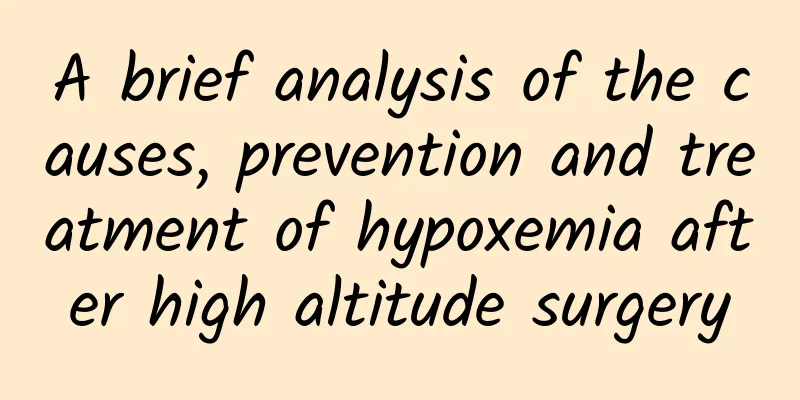A brief analysis of the causes, prevention and treatment of hypoxemia after high altitude surgery

|
At the top of the plateau, hypoxemia is a constant presence after surgery, threatening the patient's life. This article aims to analyze the root causes of hypoxemia after surgery at the plateau, explore effective prevention and treatment methods, provide a beacon for doctors, and bring hope to patients. 1. What is high altitude postoperative hypoxemia? Plateau postoperative hypoxemia refers to a condition in which the oxygen content in the blood decreases after surgery in plateau areas due to the low atmospheric pressure and thin oxygen in the area, which reduces the amount of oxygen inhaled by the human body. At the same time, the surgical trauma and the effects of anesthetics weaken the patient's ability to absorb and utilize oxygen. This condition poses a serious threat to the patient's postoperative recovery and effective measures must be taken in a timely manner to prevent and treat it. 2. What are the main causes of hypoxemia after high altitude surgery? The main causes of postoperative hypoxemia at high altitude include environmental factors, surgical trauma, the effects of anesthetics, pain and stress reactions, and pulmonary complications. The hypoxic environment at high altitude reduces the amount of oxygen inhaled by the human body, surgical trauma weakens the patient's function and oxygen intake capacity, anesthetics inhibit respiratory function, postoperative pain and stress reactions increase oxygen consumption, and pulmonary complications affect oxygen exchange. These factors interact with each other to increase the risk of hypoxemia. Therefore, comprehensive consideration and effective prevention and treatment measures must be taken during high altitude surgery. Doctors should assess the patient's condition, provide adaptation training, closely monitor during surgery, keep the airway open after surgery, provide timely oxygen therapy and deal with complications, and transfer to a low altitude area for treatment if necessary to ensure the patient's safety. 3. How to prevent hypoxemia after high altitude surgery? Measures to prevent high-altitude postoperative hypoxemia need to be considered comprehensively before, during and after surgery. First of all, before surgery in plateau areas, a comprehensive and detailed assessment of the patient's physical condition should be conducted, especially focusing on the cardiopulmonary function, in order to accurately judge the surgical tolerance and potential risks. For patients from non-plateau areas, preoperative adaptation training is essential, which helps patients improve their body's ability to adapt to the plateau hypoxic environment by gradually increasing the amount of activity and the time of exposure to the plateau environment. Secondly, during the operation, close monitoring of the patient's vital signs, especially blood oxygen saturation, is the key to preventing hypoxemia. Once signs of hypoxemia such as decreased blood oxygen saturation are found, appropriate treatment measures should be taken immediately. Finally, during the postoperative care stage, it is crucial to keep the patient's airway open, clear respiratory secretions in a timely manner, and encourage patients to perform deep breathing and coughing exercises to effectively prevent the occurrence of complications such as lung infection and atelectasis. At the same time, giving patients appropriate oxygen therapy after surgery is also an essential measure. By increasing the concentration of inhaled oxygen, it helps to quickly improve hypoxemia and promote patient recovery. 4. What are the treatments for hypoxemia after high altitude surgery? The treatment methods for postoperative hypoxemia at high altitude are diverse and need to be applied flexibly according to the specific conditions of the patients. The primary treatment is oxygen therapy, which is to give the patient high-concentration oxygen inhalation to quickly increase the oxygen content in the blood and relieve the hypoxic state. The method of oxygen therapy can be selected according to the patient's needs and the severity of the disease, including nasal cannula oxygen inhalation, mask oxygen inhalation or more advanced mechanical ventilation. Nasal cannula oxygen inhalation is suitable for patients with mild hypoxemia. It is easy to operate and comfortable; while mask oxygen inhalation and mechanical ventilation are suitable for patients with more serious conditions or who need higher concentrations of oxygen. In addition to oxygen therapy, drug therapy is also one of the important treatments for postoperative hypoxemia at high altitude. By using drugs such as bronchodilators and expectorants, the ventilation and gas exchange functions of the lungs can be improved, and the exchange of oxygen in the lungs can be promoted, thereby increasing the oxygen content in the blood. The choice of drug therapy should be determined according to the patient's specific condition and the mechanism of action of the drug to achieve the best treatment effect. During the treatment process, for possible complications, such as lung infection, atelectasis, etc., corresponding treatment measures need to be taken in a timely manner. For example, antibiotics are used to control infection, and physical therapy is performed on the lungs to prevent complications from affecting the treatment effect. In addition, supportive treatment is also an indispensable part of the treatment of hypoxemia after high altitude surgery. By maintaining the patient's water and electrolyte balance and providing adequate nutritional support, the patient's resistance can be enhanced and the treatment effect can be improved. Finally, if the patient's condition is serious and the plateau conditions cannot meet the treatment needs, the patient should be transferred to a lower altitude area for further treatment. This can avoid the further impact of the plateau environment on the patient's condition and provide better treatment conditions for the patient. Postoperative hypoxemia at high altitude has both challenges and hopes. Through in-depth exploration of its causes, we have revealed the complexity of multiple factors such as environment, surgery, and anesthesia. Under the escort of medicine, precise prevention and comprehensive treatment will work together to help patients overcome obstacles and regain the light of life. ( Li Laixi, Shanxi Yuncheng 541 General Hospital ) |
<<: Let's learn about ultrasound contrast imaging
>>: Research progress in ultrasound-guided radiofrequency ablation for thyroid nodules
Recommend
Female internal reproductive system anatomy
The female internal reproductive organs include t...
What should I eat during menstruation to increase the amount?
There are many manifestations of irregular menstr...
How long does it take for menstruation to come after induced abortion?
How long does it take to get menstruation after i...
What should I do if the Midea vacuum cleaner stops sucking? How to open and clean the Midea vacuum cleaner?
Midea vacuum cleaners are very cost-effective. Wh...
What is prenatal genetic disease testing?
Many women will do prenatal preparations before g...
What should I do if a mother has accessory breasts under her armpits?
Everyone is very familiar with normal female brea...
Symptoms of premenopause in a 51-year-old woman
Menopause is the end of a woman's menstrual p...
What will the future “new era of scientific skin care” look like?
When it comes to skin care, in the past we only k...
Lower abdominal pain and frequent urination
Lower abdominal distension and pain is also a pro...
Young man, you have been "targeted" by osteoporosis!
This is the 4751th article of Da Yi Xiao Hu Recen...
Why use sanitary napkins?
Girls do not need to use sanitary napkins when th...
Not all dairy products are suitable for kidney patients, especially these ones!
1. Whole milk Whole milk contains high levels of ...
What should girls do when they have pain during their period?
Menstruation is something that every woman needs ...
What kind of exercise can treat gynecological diseases?
Regarding the treatment of gynecological diseases...
What are the symptoms of intrauterine infection during pregnancy
Intrauterine infection during pregnancy is a seri...









